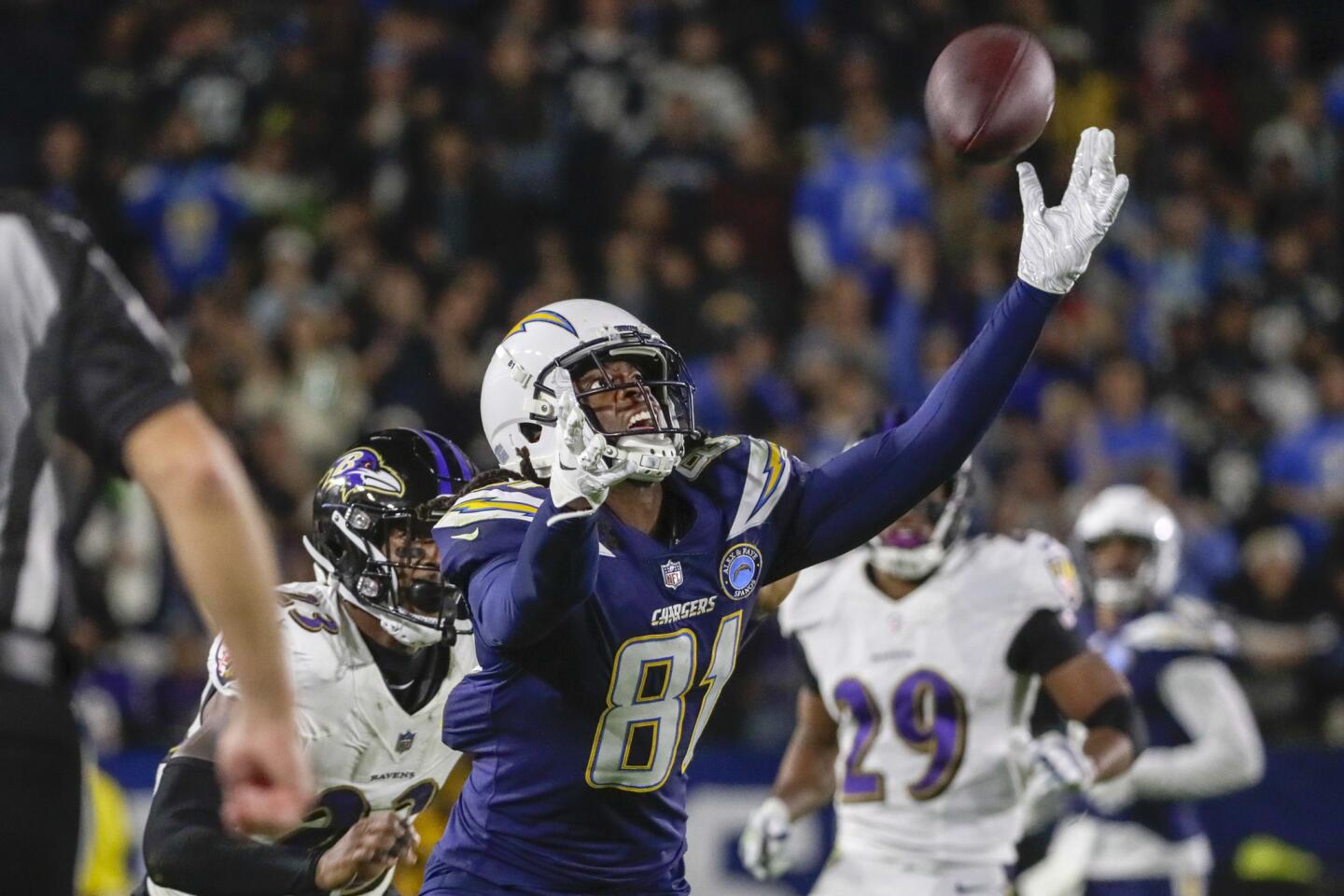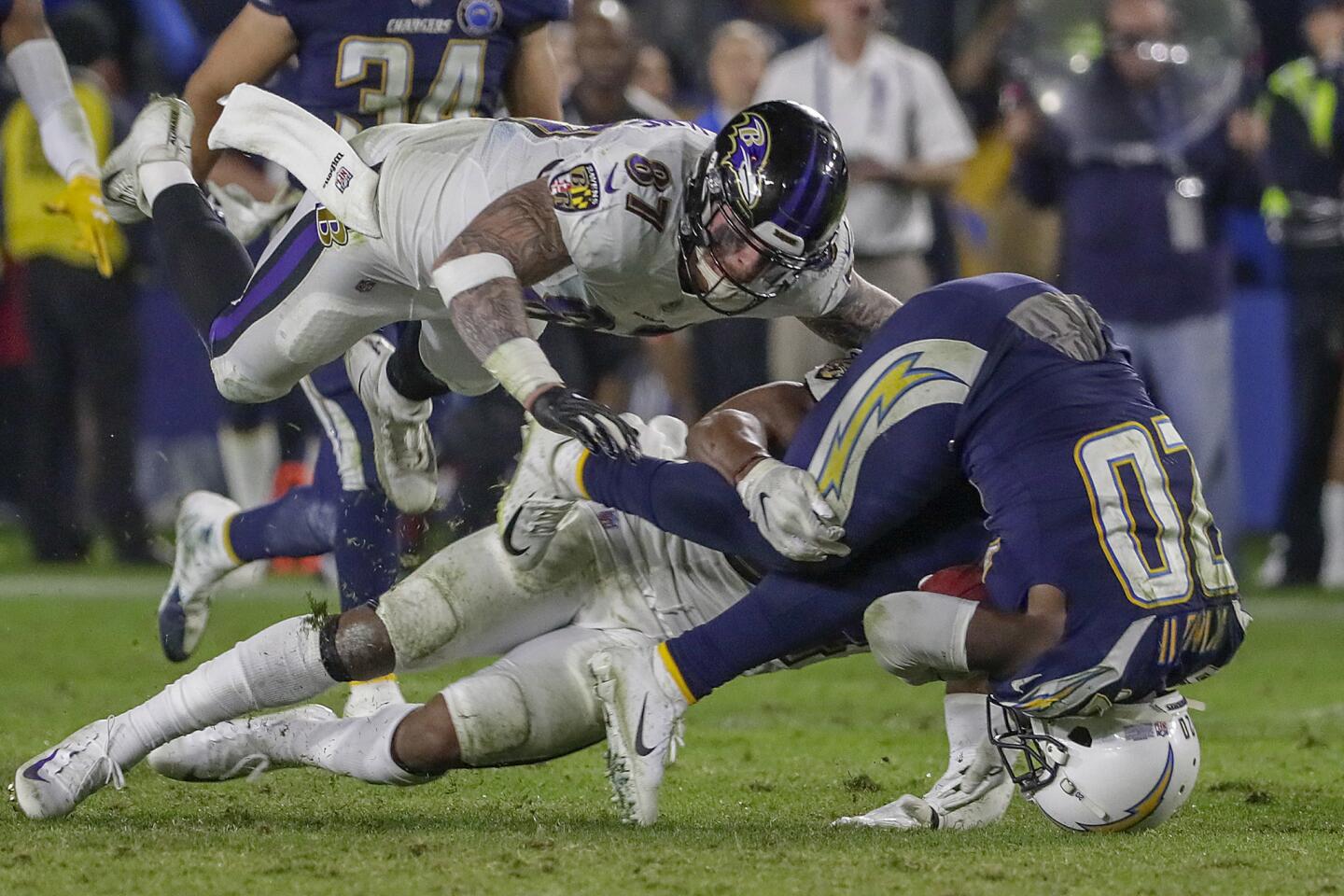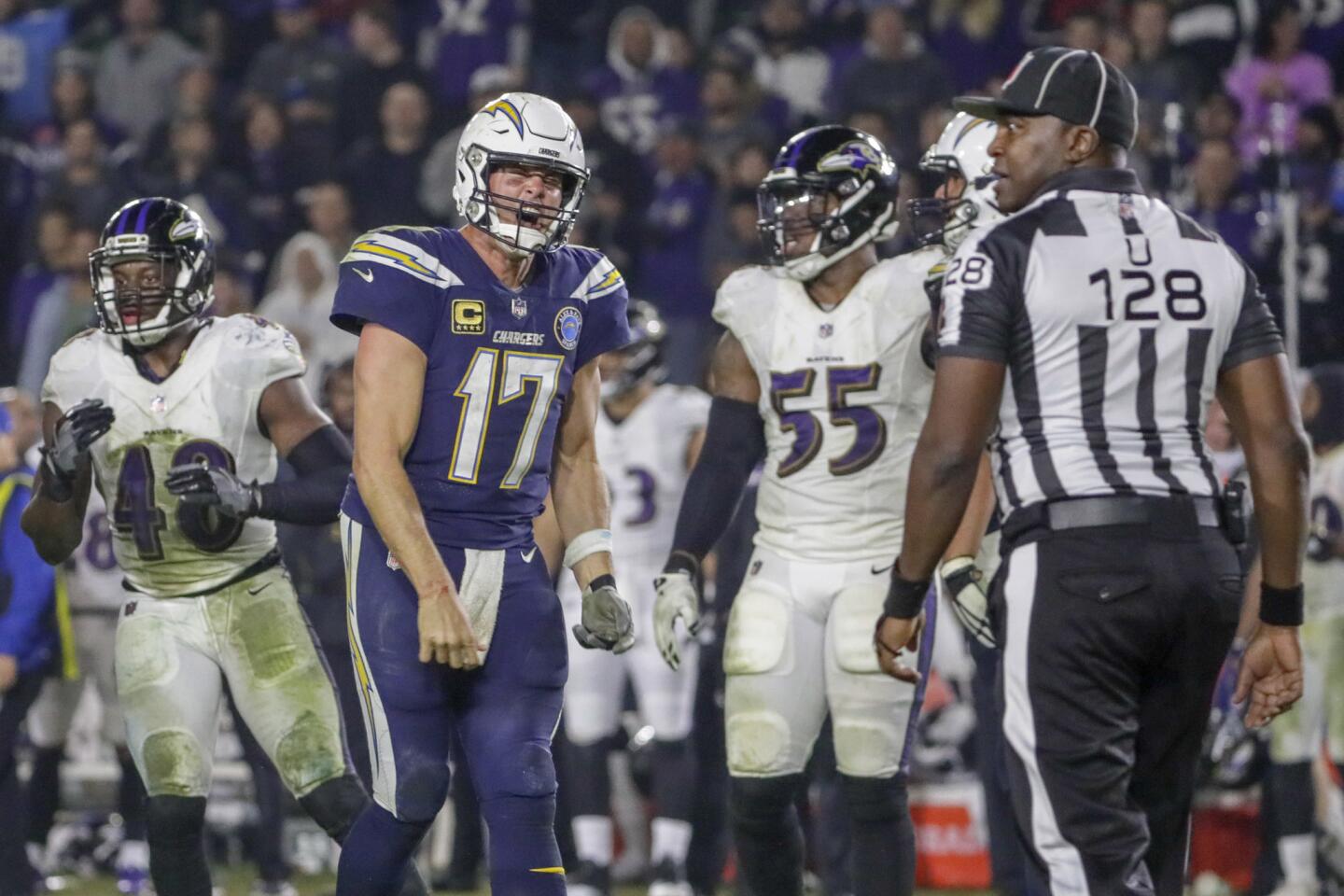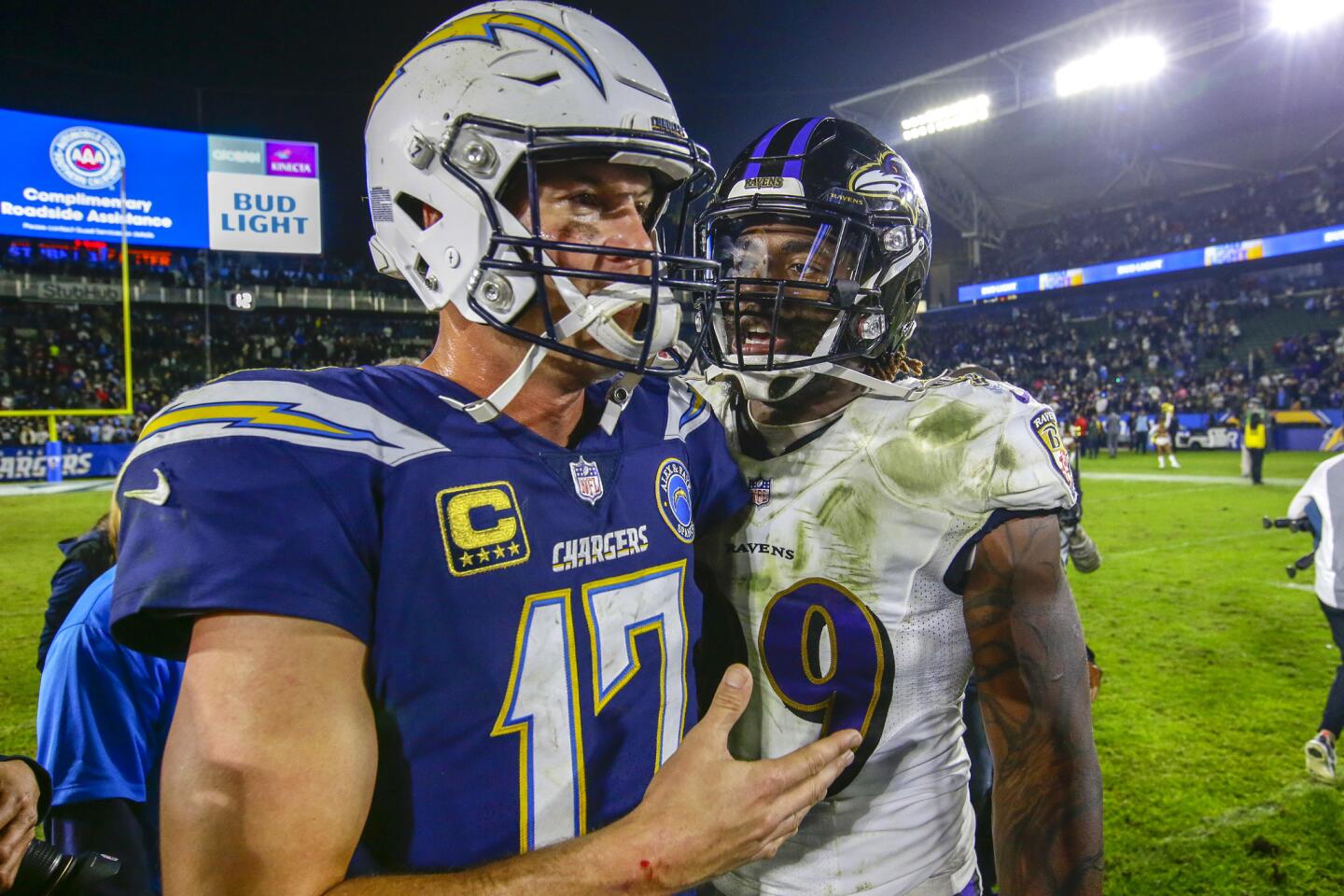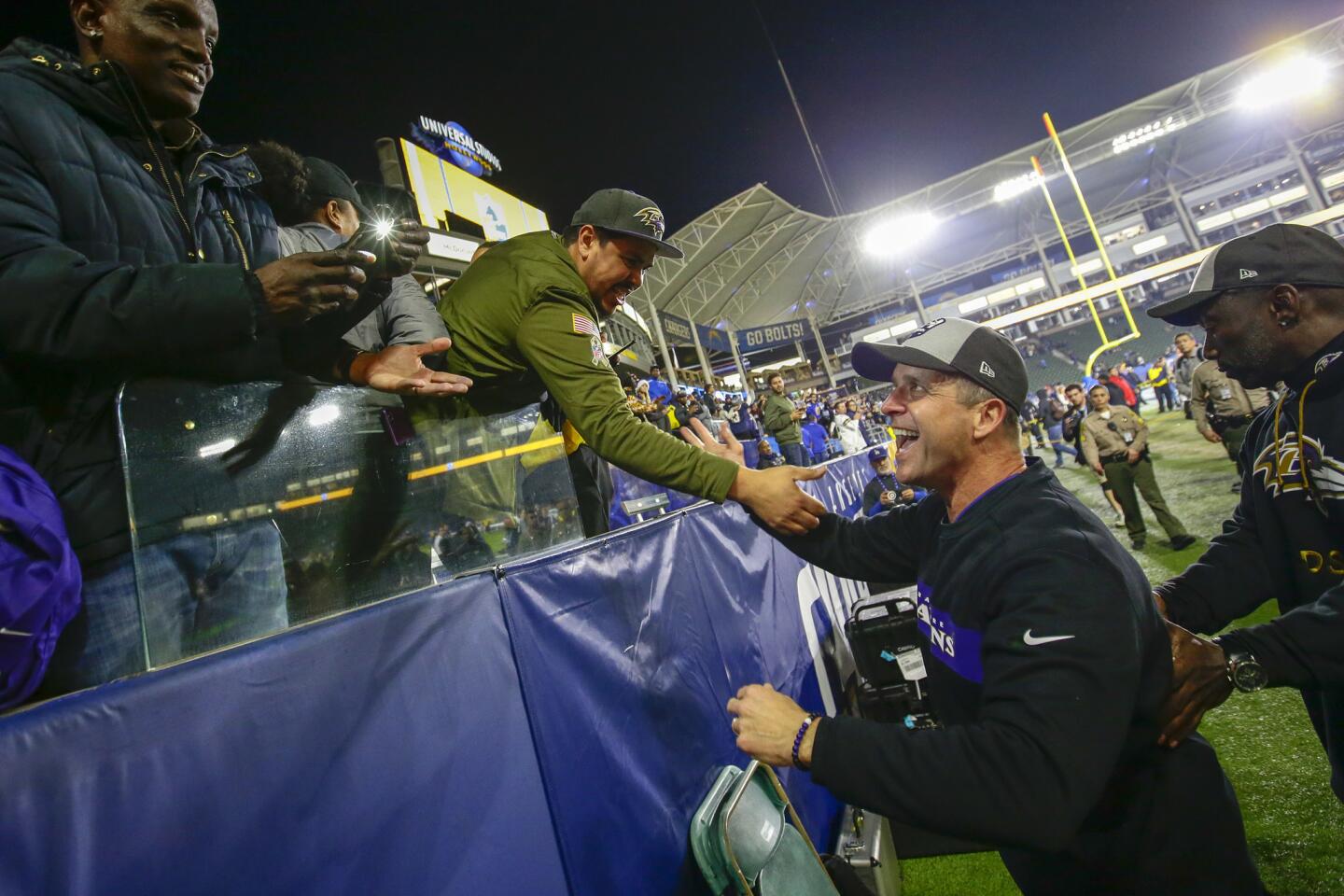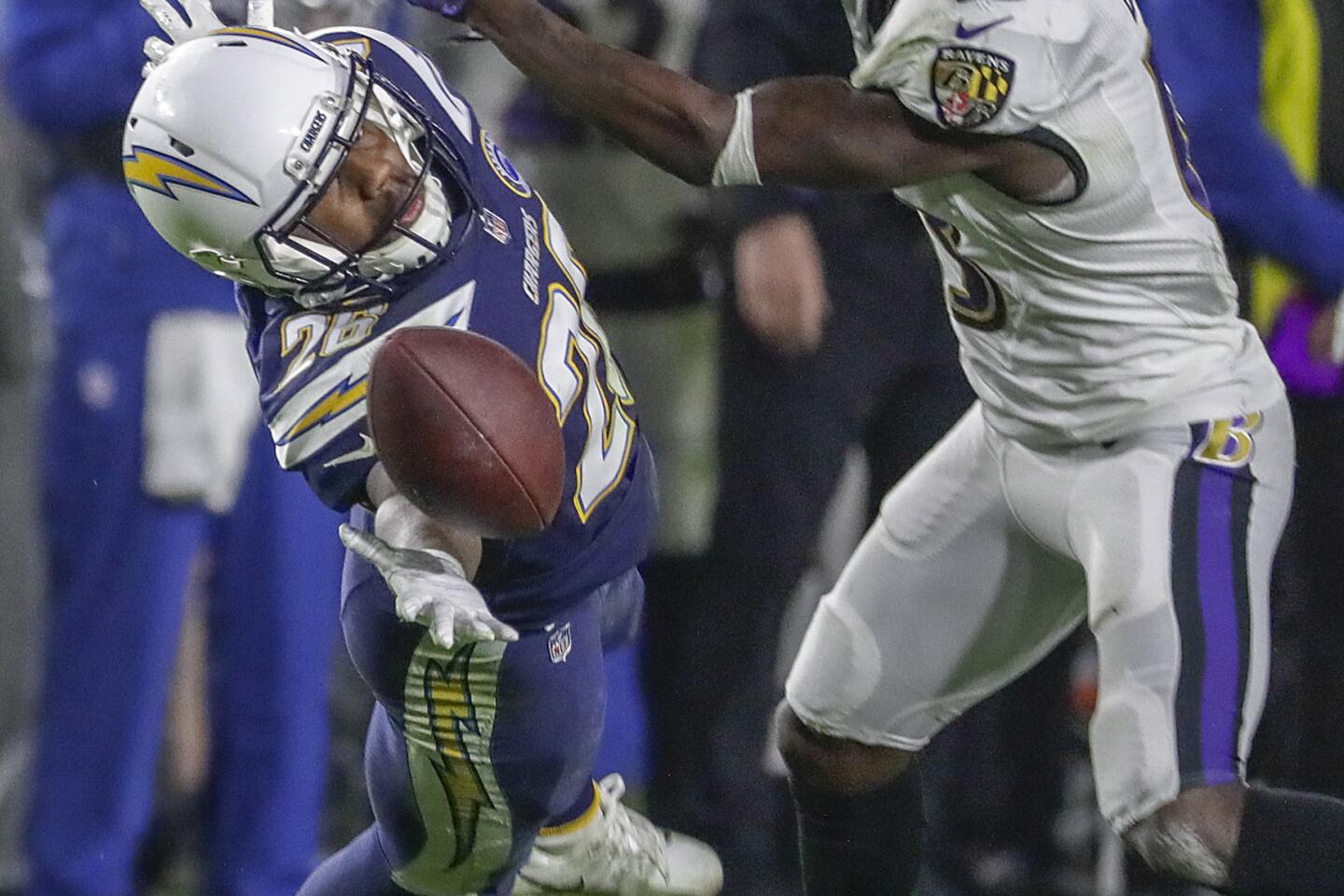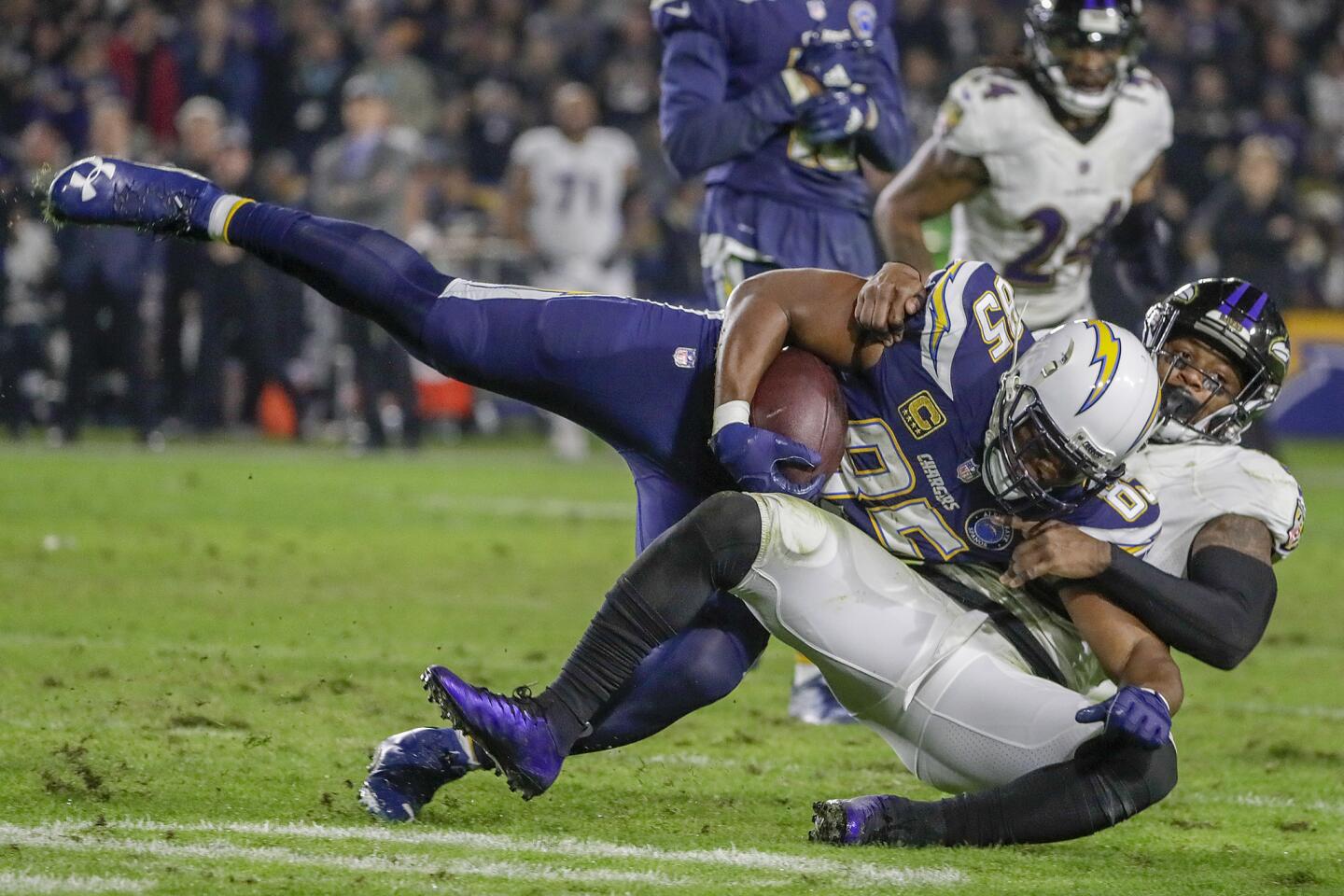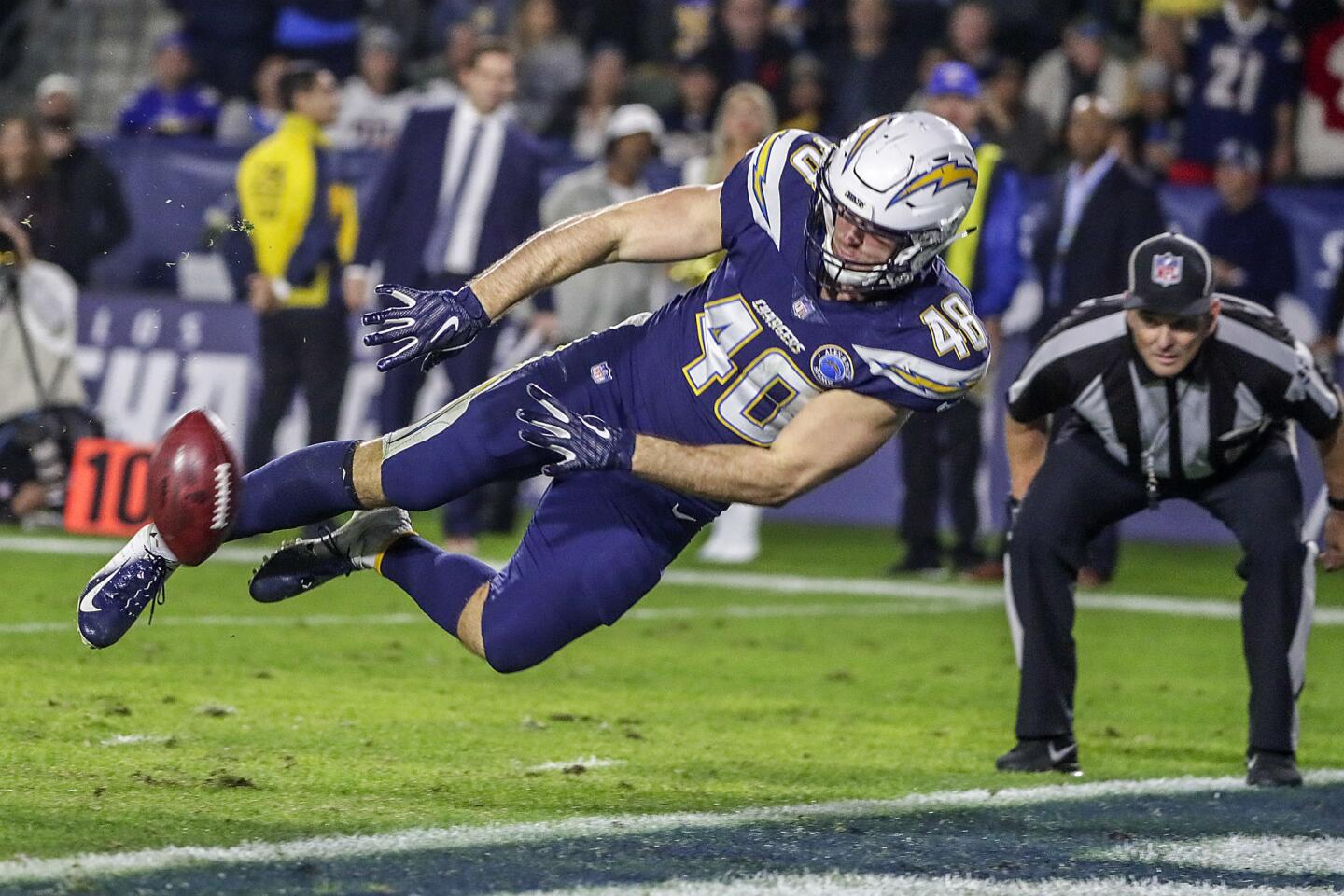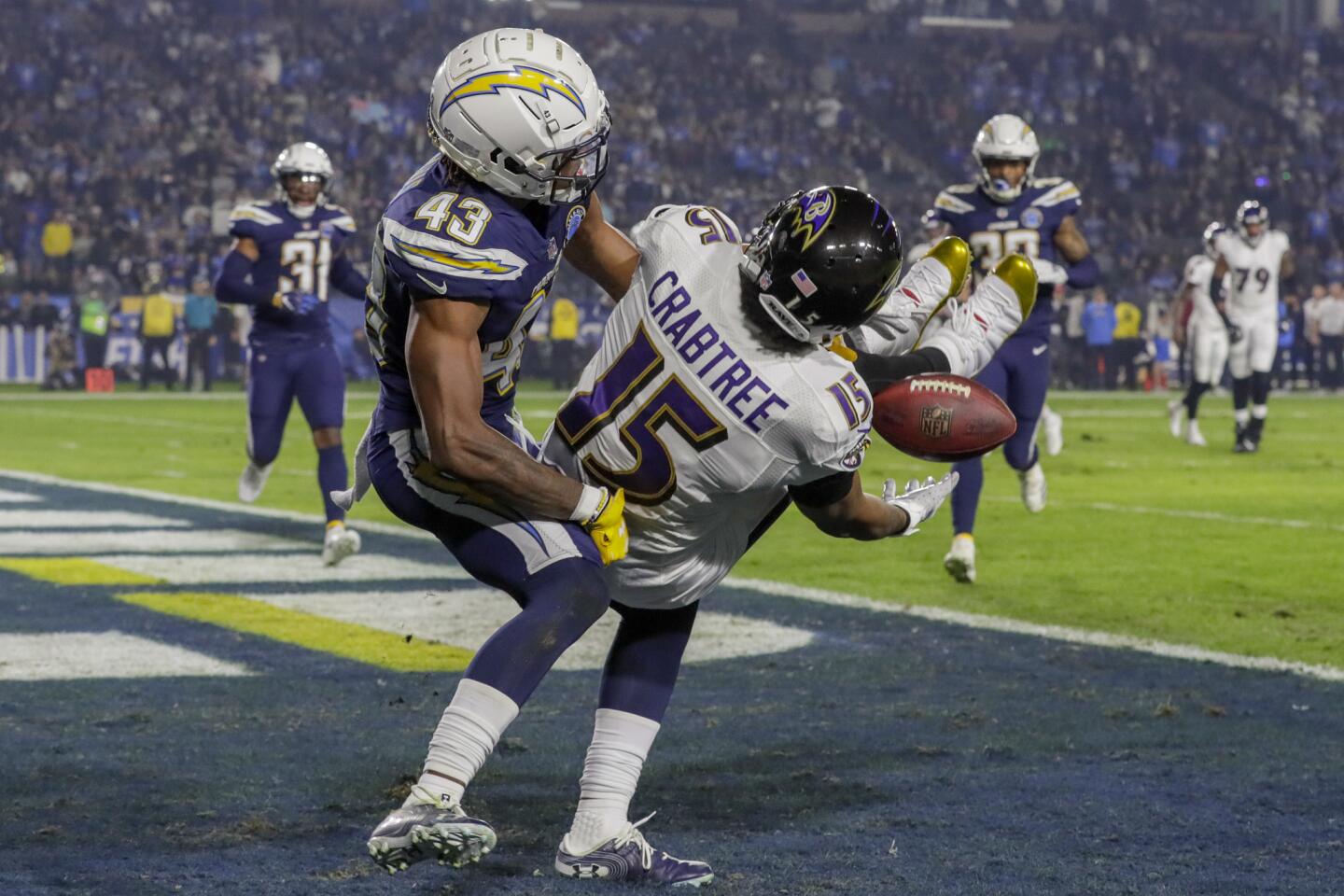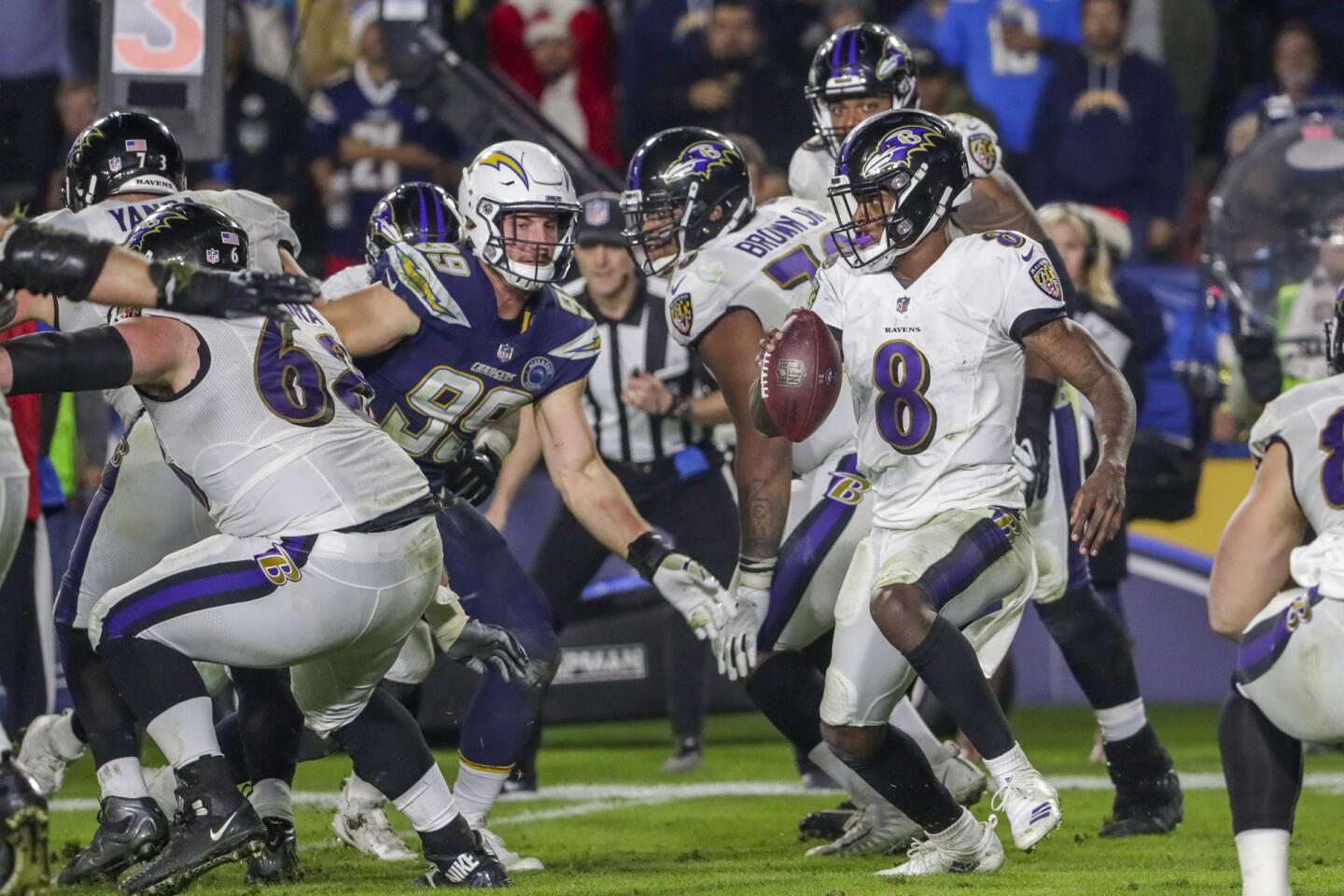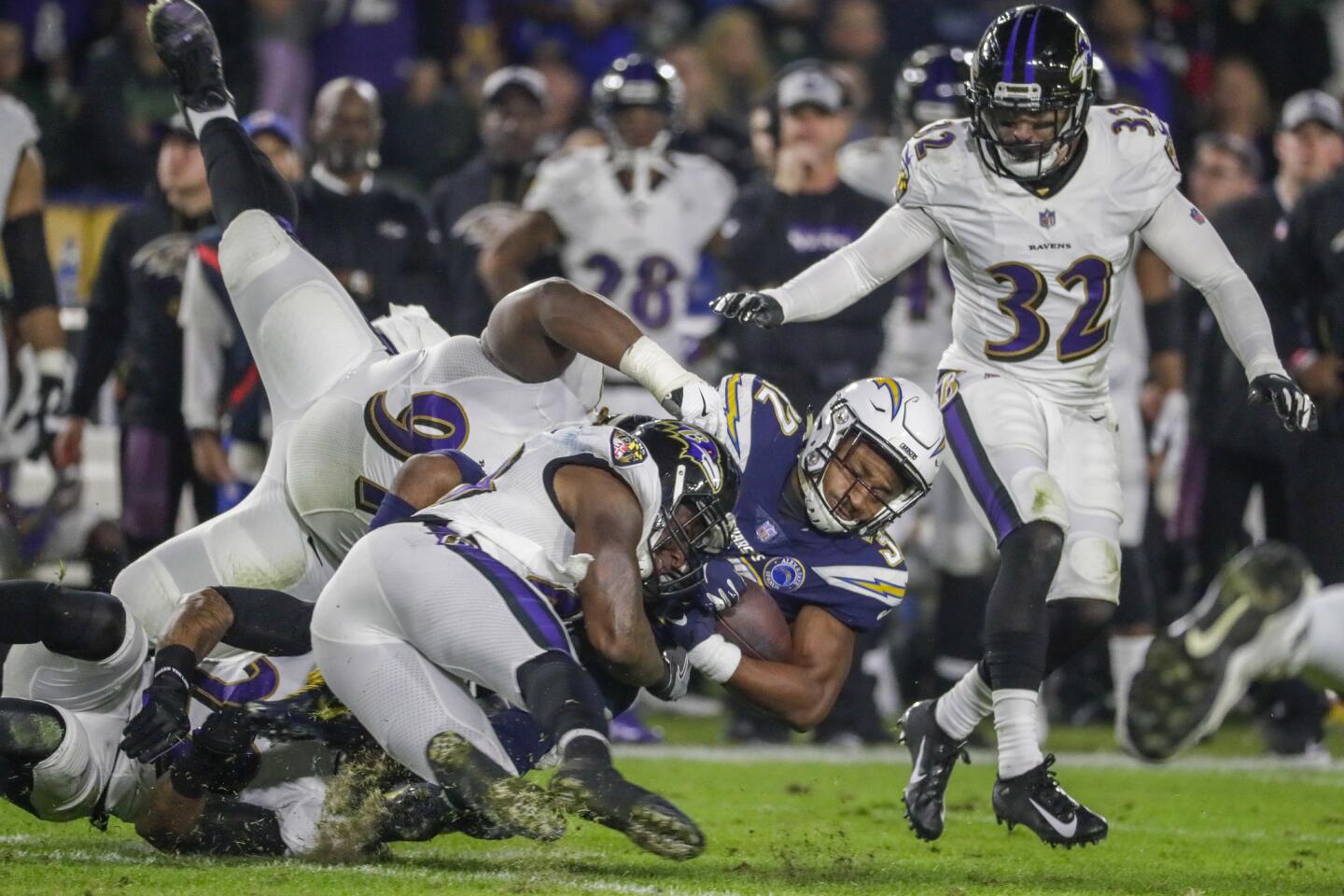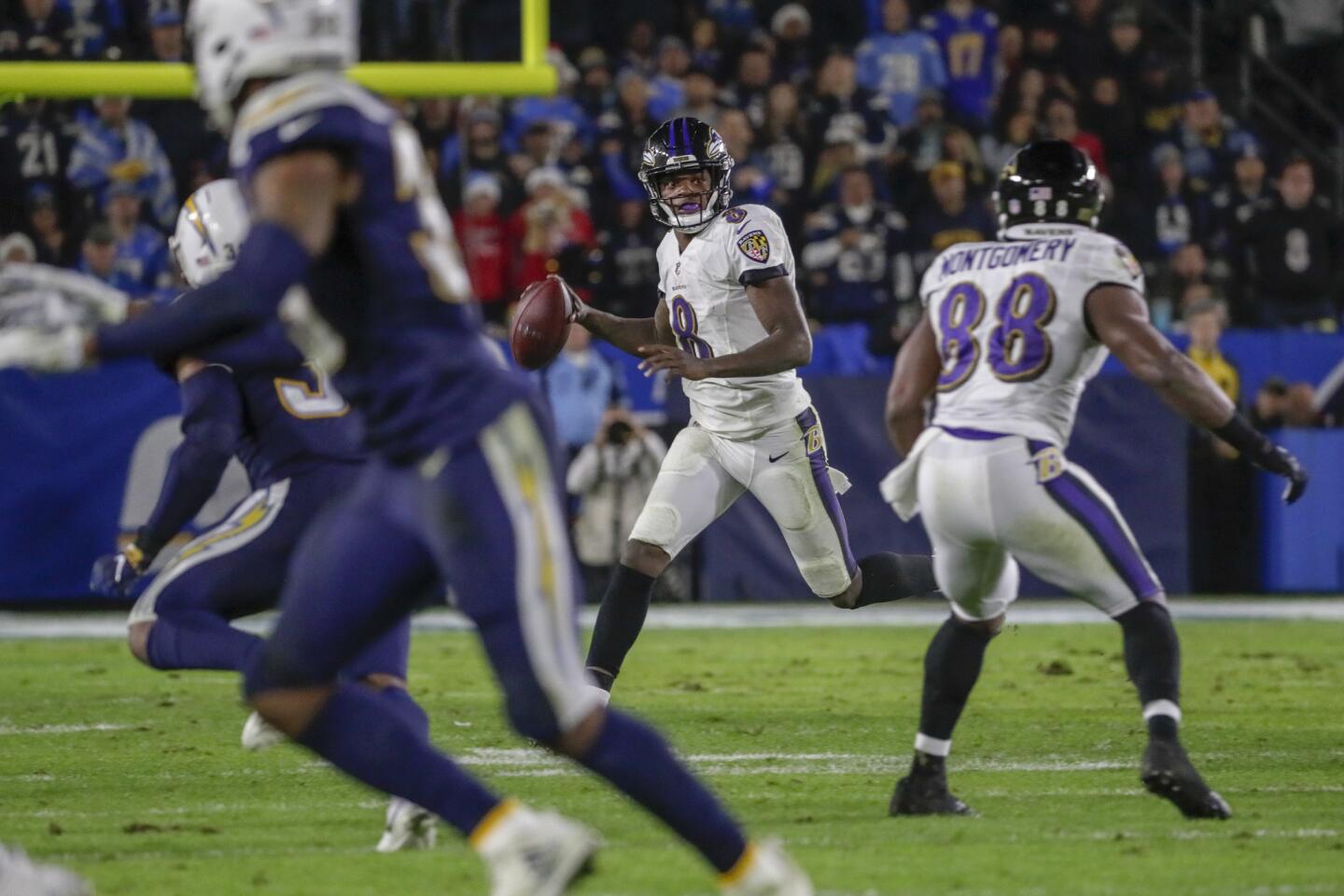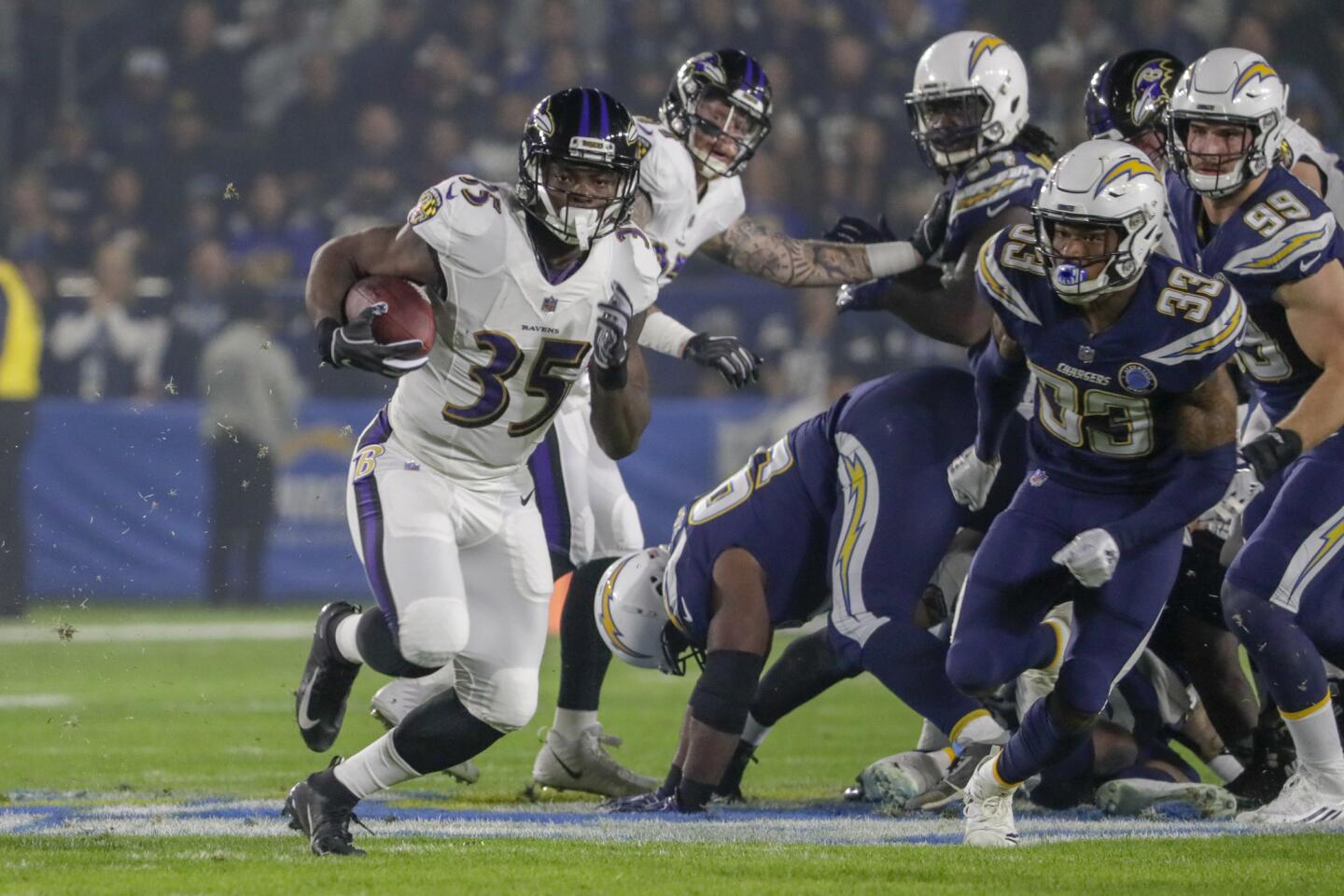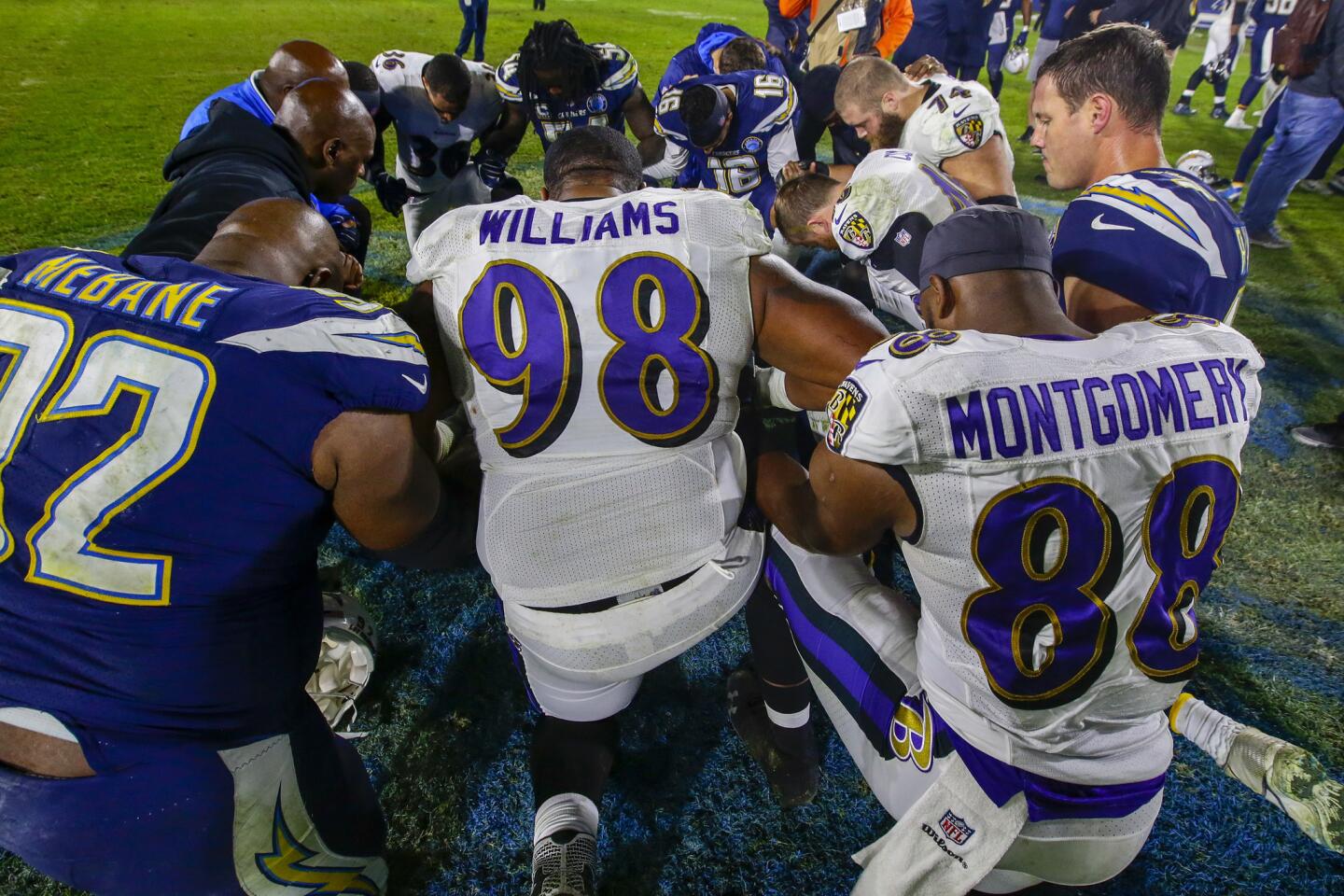Chargers’ ability to combat Ravens’ pressure will be critical in rematch, and they have options
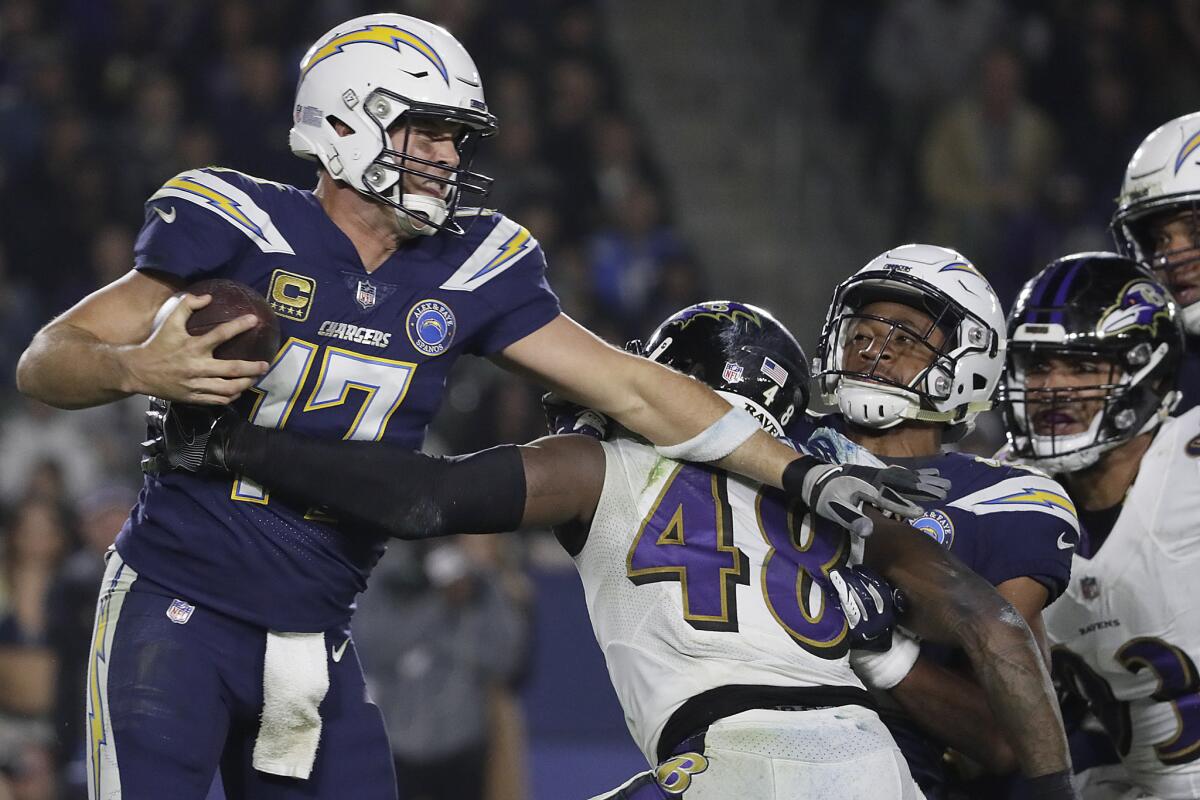
- Share via
Russell Okung compared the “pick-stunt,” a tactic favored by the Baltimore Ravens defense, to a pick-and-roll play in basketball, where a linebacker sets a screen on an offensive lineman while a defensive tackle or edge rusher rolls around the pick and barrels toward the quarterback.
A pick-and-steamroll play would be a more accurate description, seeing as how the Ravens flattened Okung and his offensive line mates in a 22-10 thrashing on the Chargers’ home field Dec. 22.
The Chargers averaged 33 points and 370 total yards during a four-game win streak over Arizona, Pittsburgh, Cincinnati and Kansas City from Nov. 25-Dec. 13, but they were reduced to a band of smothered brothers by the Ravens, who rank first in the NFL in yards (292.9) and second in points (17.9) allowed per game.
The Ravens sacked quarterback Philip Rivers four times for a loss of 34 yards while they harassed and hurried him into a season-low 51.7 passer rating, Rivers completed 23 of 37 passes for 181 yards with no touchdowns and two interceptions. Baltimore held the Chargers to season lows in points and yards (198).
For the Chargers to have any chance of beating the Ravens in Sunday’s AFC wild-card playoff game at M&T Bank Stadium, their offensive line must do a much better job of picking up Baltimore’s stunts and blitzes to give Rivers a cleaner pocket from which to operate.
“Those guys game-planned us the right way and exploited some things that we struggled with throughout the game,” said Okung, the Chargers’ veteran left tackle. “They figured out a way to get the best of us.”
They did not fool the Chargers or catch them off-guard. Okung, right tackle Sam Tevi, right guard Michael Schofield, center Mike Pouncey and left guard Dan Feeney all said they were prepared for Baltimore’s blitzes and stunts.
But the Ravens did an excellent job of disguising blitzes and spreading stunts across the line, and they funneled much of their pressure toward the middle, preventing Rivers from stepping up in the pocket and leaving the immobile 37-year-old quarterback with no escape routes.
“Their defense is known for pick-stunts and stuff like that, and they were very good at running them,” Feeney said. “We had an idea they were going to do it to us — we just didn’t execute the way we wanted to on some pass protections. We were fundamentally unsound across the board on many plays.”
A second-and-16 play from the Chargers’ 19-yard line late in the third quarter provides an example of the havoc Baltimore’s ravenous defense can create.
Ravens linebacker Patrick Onwuasor, who had nine tackles, two sacks and a forced fumble that night, lined up in the A gap, between Pouncey and Schofield. Defensive end Brent Urban took a three-point stance in the B gap between Schofield and Tevi. Outside linebacker Za’Darius Smith was on the edge.
Rivers took the snap in shotgun formation with running back Melvin Gordon to his right. While Schofield engaged Urban, Onwuasor gave Schofield a two-handed shove in the left hip, throwing Schofield off-balance, the pick in the pick-stunt.
“They’re always trying to pop your hip into the air,” said Nick Hardwick, the Chargers center from 2004-14. “If they can elevate your hip, then your foot comes off the ground, and you can’t fight back with pressure.”
After shoving Schofield, Onwuasor continued toward the backfield. While Gordon tried to pick up Onwuasor, the 6-foot-7, 300-pound Urban circled behind Onwuasor and Schofield and bore down on Gordon, who was suddenly overwhelmed by two Ravens.
The 6-4, 272-pound Smith, meanwhile, beat Tevi on the edge, and Smith and Urban converged on Rivers for a seven-yard sack, crushing Gordon amid a pile of humanity. Schofield, meanwhile, was rendered almost moot on the play.
“At times, we were trying to block half a body, or half a man,” Okung said. “It leaves you exposed, and a [defender] is more open to making a big play.”
If there is a benefit to a playoff rematch with the Ravens two weeks after sustaining such a beating, it’s that the Chargers linemen know what to expect.
“The good news is they’ve seen it once and they know what to look for, and there are only so many different variations the Ravens can run,” Hardwick said. “They’ll take a bunch of reps in practice in preparation for [those stunts and blitzes] and other variations off of that.
“They won’t see the same look from the Ravens, but it will be something similar or something disguised differently that ends up the same. Or it’s going to look the same and they’ll invert the rush, where the A gap guy will penetrate first and the defensive end will wrap. You’ll have worked on all those variations.”
Pre-snap recognition and anticipation and post-snap reaction will be key for the Chargers.
“You have to see it beforehand, and that takes a lot of film study,” Okung said. “And when it happens, you have to be ready for it and be able to play off of it the right way, and that’s not easy.”
Feeney said the Chargers must be cleaner with their switches, so one lineman is not left blocking half a player while a teammate is left with two defenders.
The Chargers could also mix up pass protections, with the entire line sometimes dropping back in unison and linemen picking up the closest rushers instead of trying to switch assignments at the point of attack.
“The Chargers line at times sits firm into the line of scrimmage, which is great for Philip Rivers because he has a nice firm pocket,” Hardwick said. “But when you’re getting a lot of pick-stunts, sometimes it’s better to just level back onto the same plane. That way your guard and tackle’s shoulder-pad depth is synced up and there are no seams.”
Another way to counter Baltimore’s stunts and blitzes seems counter-intuitive. While the Chargers often kept Gordon and Justin Jackson in the backfield to help protect Rivers in the Dec. 22 game, Hardwick said the Chargers might be better off targeting their running backs in the pass game.
“One thing you can most certainly do is empty the backfield pre-snap or clear out the running back on the snap and not force him to block,” Hardwick said. “You try to create a mismatch in space that way.”
Rivers turned two such “hot reads” on Raiders blitzes into touchdowns this season, throwing quickly into the left flat to Austin Ekeler for a 44-yard scoring strike against Oakland on Oct. 7 and to Gordon for a 66-yard scoring play at Oakland on Nov. 11.
“A blitzing linebacker usually eliminates the running back as an outlet receiver and forces him to block,” Hardwick said. “But if you send the running back out, you’re going to force a defensive end or edge rusher to peel off to whatever side the back releases to and create a little mismatch in space. If you can convert some of those and burn them quickly, then they get kind of hesitant on those dogs.”
An effective running game would ease some pressure on Rivers and the line, but that won’t be easy. The Ravens rank fourth in the NFL in rushing defense, giving up an average of 82.9 yards a game, and they held the Chargers to 51 yards in 16 carries, an average of 3.2 yards, in the Dec. 22 game.
The Ravens also neutralized Rivers’ ability to anticipate blitzes and get rid of the ball quickly by using tight press coverage against the Chargers’ slot receivers and wide receivers when they brought pressure.
Led by Pro Bowl safety Eric Weddle, the former Charger, and Pro Bowl linebacker C.J. Mosley, the Ravens are as tough in the secondary as they are in the trenches.
This Ravens defense might not be quite as stingy as the Ray Lewis-led, Super Bowl-winning 2000 unit, which held opponents to 10.3 points a game, but it will present a formidable obstacle for the Chargers on Sunday.
“I thought across the board, not just in the box, they were physical,” Hardwick said of the Ravens defense in the Dec. 22 game. “They made you earn every single ounce of air that you were breathing in. From the receivers to the tight ends to the running backs, they made you earn every inch you were gaining.
“To me, that was really impressive, how combative of a defensive unit they are. And that’s essentially Ravens football.”
Twitter: @MikeDiGiovanna
More to Read
Go beyond the scoreboard
Get the latest on L.A.'s teams in the daily Sports Report newsletter.
You may occasionally receive promotional content from the Los Angeles Times.

